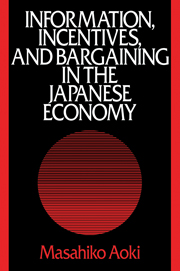 Information, Incentives and Bargaining in the Japanese Economy
Information, Incentives and Bargaining in the Japanese Economy Published online by Cambridge University Press: 14 January 2010
In Section 4.1, we saw that predominant intercorporate stockholdings in Japan have given rise to two types of corporate groups: capital-keiretsu, or subsidiary groups; and former zaibatsu, or financial keiretsu. In this chapter, I focus on the transactional aspects of these two groups. In dealing with the first type, however, I concentrate on a special class of capital-keiretsu characterized by a particular transactional feature, that is, the subcontracting group, which is a stratified, quasi-permanent group of suppliers subcontracting to a major manufacturer.
The bargaining game analysis in Chapter 5 suggested that the coalitional firm tends to limit the size of its employment in order to protect the vested interests of its incumbent employees. I have called this phenomenon the “dilemma of industrial democracy,” because the voice of incumbent employees is enhanced within the firm to the detriment of outsiders' interests. I have argued that this dilemma is manifested in the J-firm in the form of differential employment status (such as that of part-time workers) and have hinted that, to some extent, the increasing hiving off of subsidiaries and reliance on subcontractors by the J-firm may be a similar phenomenon. This may sound like the old dual structure hypothesis: Large Japanese firms exploit their monopsonic positions to make use of smaller subcontracting suppliers as a business cycle buffer.
But the subcontracting group formed by the major contracting firm and its satellite supplier firms is a complex economic institution.
To save this book to your Kindle, first ensure [email protected] is added to your Approved Personal Document E-mail List under your Personal Document Settings on the Manage Your Content and Devices page of your Amazon account. Then enter the ‘name’ part of your Kindle email address below. Find out more about saving to your Kindle.
Note you can select to save to either the @free.kindle.com or @kindle.com variations. ‘@free.kindle.com’ emails are free but can only be saved to your device when it is connected to wi-fi. ‘@kindle.com’ emails can be delivered even when you are not connected to wi-fi, but note that service fees apply.
Find out more about the Kindle Personal Document Service.
To save content items to your account, please confirm that you agree to abide by our usage policies. If this is the first time you use this feature, you will be asked to authorise Cambridge Core to connect with your account. Find out more about saving content to Dropbox.
To save content items to your account, please confirm that you agree to abide by our usage policies. If this is the first time you use this feature, you will be asked to authorise Cambridge Core to connect with your account. Find out more about saving content to Google Drive.